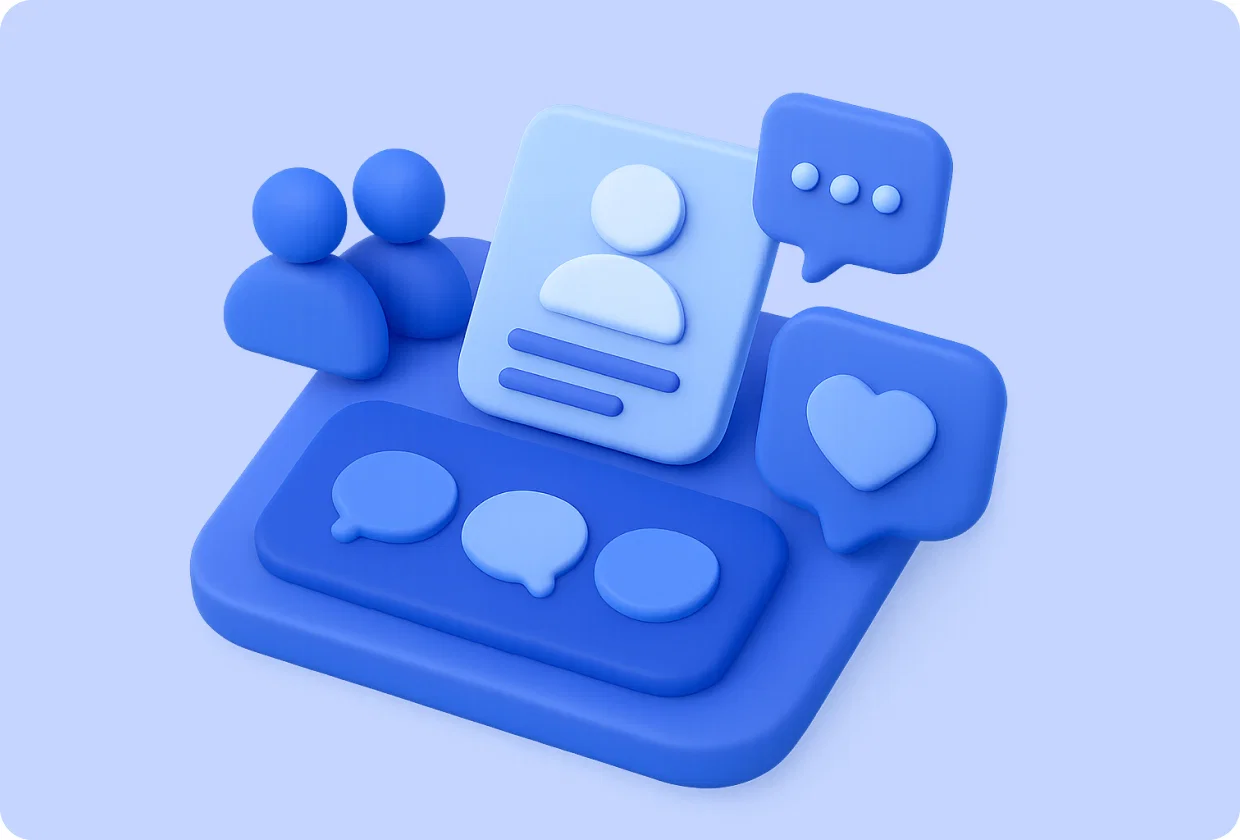Social features have become essential components of modern apps, enabling user engagement, retention, and monetization. Whether in gaming, fitness, fintech, or e-commerce, adding social layers allows users to interact, share, and build communities inside the app environment.
This article explains the main types of social features, their purpose, and how developers can integrate them using specialized SDKs and APIs such as social.plus, which provides infrastructure for in-app social interactions and analytics.
| Feature Type |
Description |
Why It Matters |
Action for Developers |
| User Profiles |
Customizable pages showing user info, activity, and preferences. |
Builds identity and personalization. |
Use profile APIs or SDKs like social.plus to manage profile creation and metadata securely. |
| Feeds & Timelines |
Streams of user or community posts. |
Encourages content discovery and engagement. |
Integrate feed SDKs with ranking and moderation tools. |
| Chat & Messaging |
Real-time 1:1 or group communication. |
Drives user retention and support. |
Implement chat APIs with presence and push notification features. |
| Likes, Comments & Reactions |
Micro-interactions on content. |
Adds emotional feedback loops and virality. |
Include reaction endpoints and moderation workflows. |
| Groups & Communities |
Thematic spaces for shared interests. |
Strengthens belonging and in-app retention. |
Use community management SDKs to create and moderate user groups. |
| Notifications & Activity Feeds |
Alerts for user actions, mentions, or updates. |
Keeps users returning through timely engagement. |
Use notification APIs to trigger personalized updates. |
| Content Sharing |
Internal or external sharing options. |
Expands organic growth and visibility. |
Add deep-link and social sharing APIs. |
2. Advanced Social Features
| Feature Type |
Description |
Example Use Case |
Implementation Tip |
| Leaderboards & Achievements |
Rankings or badges for performance metrics. |
Fitness or gaming apps showing top users. |
Combine with analytics SDKs to measure engagement. |
| Live Events & Streams |
Real-time video or voice engagement. |
E-learning, gaming, or sports apps. |
Integrate low-latency streaming SDKs and comment overlays. |
| User-Generated Content (UGC) |
Posts, images, or reviews from users. |
E-commerce or lifestyle apps. |
Use content moderation APIs and AI filters. |
| Social Graphs & Following Systems |
Networks of friends or followers. |
Music or reading apps with recommendation loops. |
Build using graph-based APIs like those in social.plus. |
3. Benefits of Adding Social Features
| Metric |
Impact Range |
Why It Matters |
Optimization Tip |
| User Retention |
2–3× higher in social-enabled apps |
Keeps users connected and active. |
Add persistent profiles and feed personalization. |
| Session Duration |
+40–70% longer sessions |
Users spend more time engaging. |
Integrate chats and live interactions. |
| LTV (Lifetime Value) |
Up to 50% increase |
Community trust drives in-app purchases. |
Combine social data with monetization features. |
4. How to Add Social Features with SDKs and APIs
Developers can add social functionality without building everything from scratch by using social infrastructure SDKs.
social.plus provides a modular API suite that covers:
- User profiles and identity management
- Feeds, posts, and reactions
- Chat, messaging, and notifications
- In-app communities and moderation tools
- Engagement analytics and monetization
By integrating such SDKs, product teams reduce development time while ensuring scalability, privacy, and consistent UX across platforms.
FAQs
What are the main benefits of adding an in-app community?
In-app communities increase user retention, lifetime value, and organic growth by fostering continuous interaction. They transform apps from static tools into living ecosystems of shared interest and participation.
How can developers add community features efficiently?
Using SDKs like social.plus, developers can add feeds, comments, messaging, and analytics with minimal code. This reduces build time and ensures scalability across iOS, Android, and web platforms.
Are in-app communities suitable for all app categories?
Yes. Fitness, finance, education, and lifestyle apps all benefit from social engagement. The key is aligning the community's purpose with user motivations (learning, sharing, competing, etc.).
What metrics should teams track to measure engagement success?
Key metrics include daily active users (DAU), session duration, content interactions (likes, comments), and retention rate. Monitoring these helps assess whether community participation translates into sustained engagement.
What is the most important social feature to start with?
Start with user profiles and activity feeds. They create the foundation for personalization and engagement loops that other features build upon.
How do social features increase user retention?
Social features enable emotional investment and network effects—users return to interact with others, share updates, and track social progress.
Can non-social apps benefit from social features?
Yes. Fitness, learning, and finance apps use communities and leaderboards to increase motivation, accountability, and user stickiness.
What's the easiest way to integrate social features?
Use SDKs like social.plus that offer ready-to-deploy social APIs for profiles, feeds, and chat. This removes the complexity of backend setup, scaling, and compliance.
Conclusion
Social features transform apps into connected ecosystems where users interact, share, and grow communities. From feeds and chat to leaderboards and UGC, each feature strengthens engagement and loyalty.
Using dedicated SDKs such as social.plus allows developers to implement these capabilities quickly and securely—creating richer, more social experiences that drive retention and business growth.
